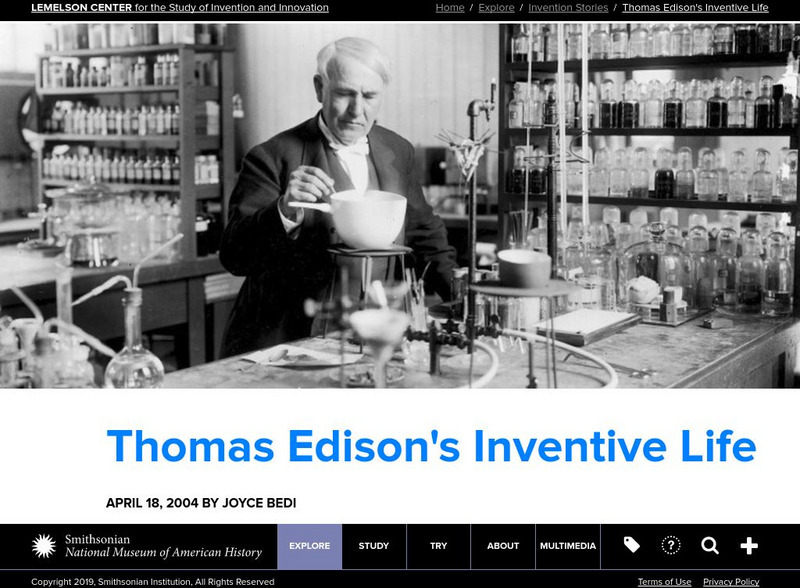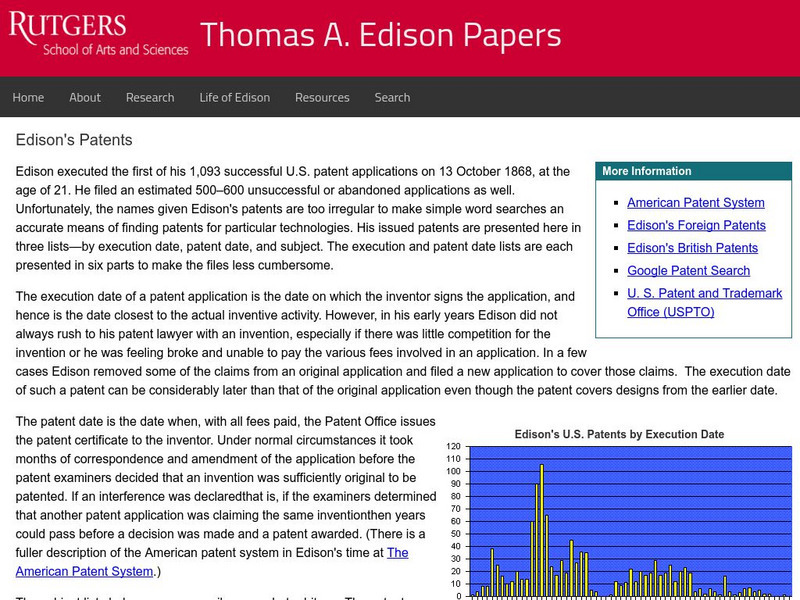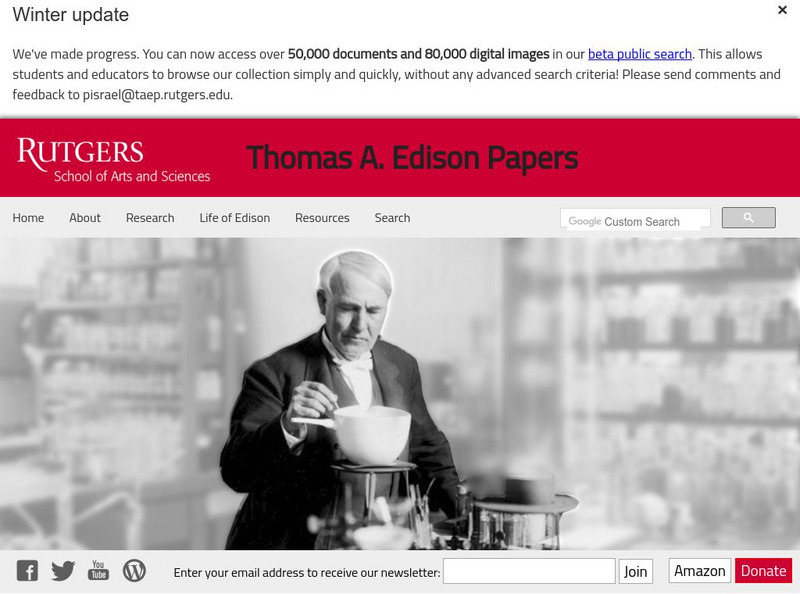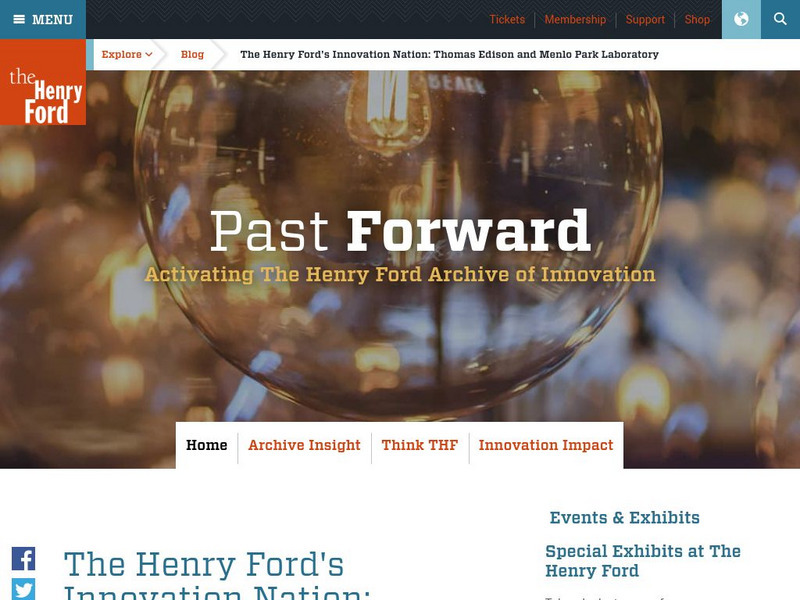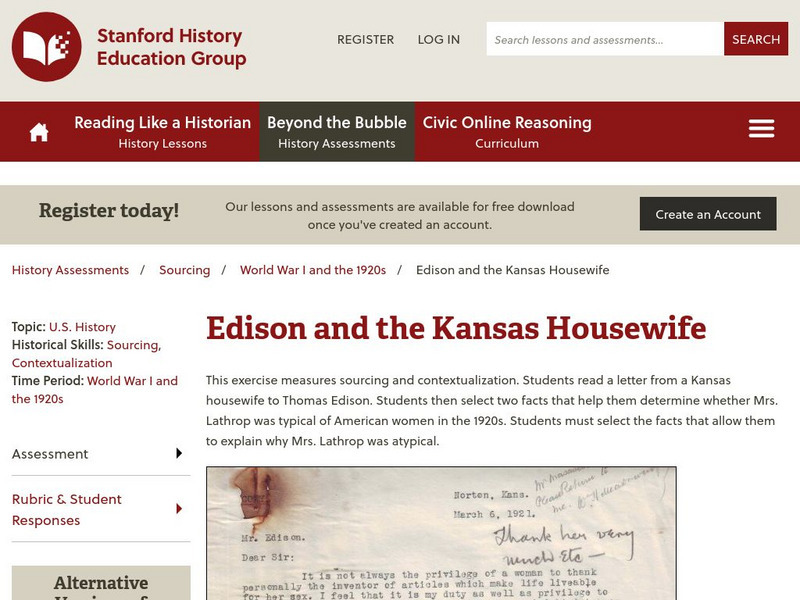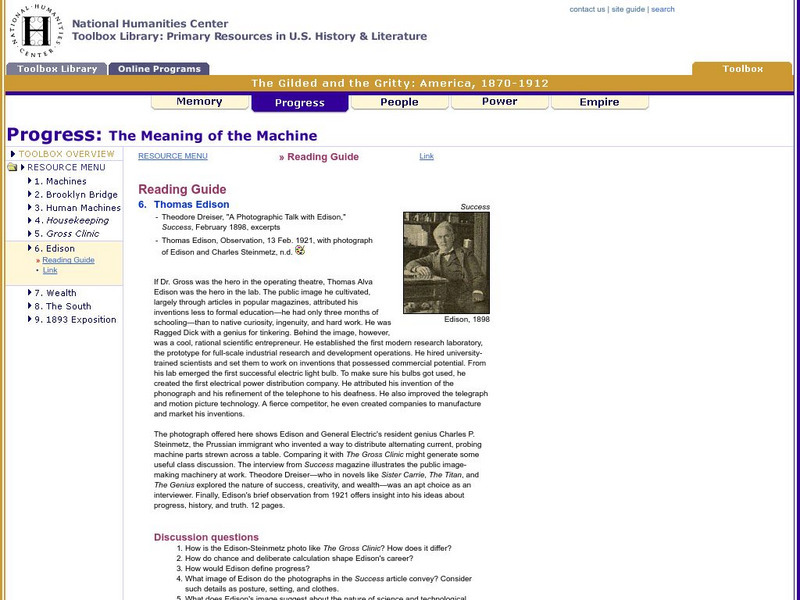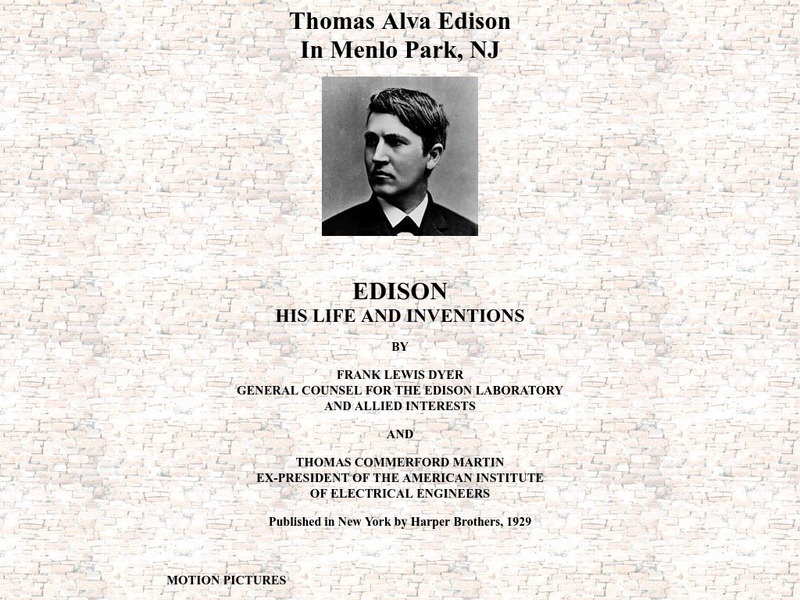National Endowment for the Humanities
Neh: Edsit Ement: Thomas Edison's Inventions in 1900s and Today: From New to You!
In this lesson plan, students will consider "Thomas Edison's Inventions in the 1900s and Today: From "New" to You!." The plan includes worksheets and other student materials that can be found under the resource tab.
Science Struck
Science Struck: Timeline of Thomas Edison's Inventions
Describes Thomas Edison's inventions in chronological order from 1868 to 1915, with mention of his contribution to World War I.
Curated OER
National Park Service: The Invention Factory:thomas Edison's Laboratories
This Teaching With Historic Places lesson plan about Thomas Edison's laboratories is filled with maps, readings, critical thinking questions, and photographs related to Edison's labs and inventions. This site explains and details the...
Smithsonian Institution
Lemelson Center: Thomas Edison's Inventive Life
This site is a complete resource for learning about Edison's life, his inventions, and electricity. If you like experimenting, there are instructions included for how to make your own light bulb. Good photos.
Smithsonian Institution
Lemelson Center: Thomas Edison's Places of Invention
An article by Paul Israel from the Prototype newsletter discusses the various laboratories used by Thomas Edison as he was developing his inventions.
Rutgers University
Thomas Edison Papers: Edison's Patents
This site offers an exhaustive list of 1,093 patents granted to Thomas Edison. There is also a graphic representing his annual output available. Hyperlinks to much more information. Included are the actual drawings of inventions...
Curated OER
National Park Service: Thomas Edison National Historical Park: Edison Biography
Here is a very detailed biography of Thomas Edison ranging from his boyhood and his work as a telegrapher, moving on to his invention of the phonograph and incandescent light bulb, and finally, a description of his laboratories where he...
Other
Edison Birthplace Museum: Patents Granted to Thomas Edison
Thomas Edison is one of the world's greatest inventors and has been responsible for more inventions than any other inventor. Here is a chronological listing of the over 1,000 patents he was granted during his lifetime.
Rutgers University
Rutgers: The Thomas Edison Papers
Links to copies of papers written by Thomas Edison. Also includes biographical information and copies of his patents and companies.
Other
Earliest Voices: Thomas Edison
This resource offers historic voice recordings of Thomas Edison. There is a recording of animal sounds, and a speech given at an electrical exhibition in 1908. A biography and downloadable images of him are also included.
A&E Television
History.com: 6 Key Inventions by Thomas Edison
Edison's genius was improving on others' technologies and making them more practical for the general public. Thomas Edison applied for his first patent in 1868, when he was just 21 years old. The famous inventor's first brainchild was...
Rutgers University
Thomas Edison Papers: Biography of Thomas Edison
The first person to make the storage battery practical, with 147 patents, Edison's life is a testimony to invention. This biography, in outline form, is in two parts; go to 1879 site after this.
Science Struck
Science Struck: Facts About Thomas Edison
Read about the life of Thomas Edison and his many inventions.
Other
History of Recording Technology: Edison's Invention of the Phonograph
Click through the pages on this site to read about Edison's development of the phonograph as well as a discussion of Edison's rivals who were seeking to develop a similar product. Read about the changes in the ways to record sound as the...
Curated OER
National Park Service: Thomas Edison National Historical Park: Thomas Edison
This site includes information about Thomas Edison's inventions and his home and family life. Find a lengthy biography and several sounds from Edison's original phonograph.
Library of Congress
Loc: Learning Page: Thomas Edison
This resource provides lesson plans and information about Thomas Edison and his inventions.
The Henry Ford
The Henry Ford: Thomas A. Edison and the Menlo Park Laboratory
This site, presented by the Henry Ford Museum and Greenfield Village, offers a peek into the life and inventions of Thomas Edison. Content is focused mainly on Edison's Menlo Park Laboratory and his invention of the first practical...
PBS
Pbs Learning Media: What Edison Teaches Us About Success
In this interactive lesson, learners examine Thomas Edison's character traits and how they contributed to his becoming one of the greatest inventors in history. In this interactive lesson, students watch videos to gather evidence about...
Stanford University
Beyond the Bubble: Edison and the Kansas Housewife
[Free Registration/Login Required] Students read a letter from a Mrs. W.C. Lathrop to Thomas Edison thanking him for inventing her electric appliances and making her life easier. They are then presented with some contextual facts, and...
Rutgers University
Thomas Edison Papers: Latimer's Patents
Find a list of patents issued to African-American inventor, Lewis Latimer, to him individually or with another inventor. Clicking on the invention takes you a diagram of the invention as well as its description submitted to the U.S....
National Humanities Center
National Humanities Center: Toolbox Library: Progress: The Meaning of the Machine: Thomas Edison
A photograph of Edison and an interview of Edison by Theodore Dreiser that displays the inventor's convictions about progress in America.
Curated OER
National Park Service: Dison National Historical Site: The Invention Factory
This terrific interactive site from the National Park Service describes the different buildings on Thomas Edison's West Orange, New Jersey's laboratory facility. After exploring the buildings, follow Edison's invention and application of...
Other
Edison:life and Inventions/motion Pictures
This page is part of an online text of a book published in 1929 by Dyer and Martin on the life and work of inventor Thomas Edison. Discusses Edison's role in the development of motion pictures, but be sure to view the rest of the book...



